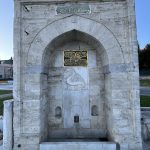“Seven Towers”
Yedikule is the İstanbul equivalent of London’s Tower of London, full of stories of gory deaths and executions in a dramatically fortified castle, in this case within walking distance of the Sea of Marmara. Its seven towers lord it over a small meydan in a quiet part of town just a short walk away from a long stretch of the Land Walls that defended Constantinople against capture until the Ottomans finally defeated the Byzantines in 1453.
Expansion of the coast road has led to the smaller and more elegant Mermerkule (Marble Tower) winding up, like the Walls, in a small park. Originally it stood right on the seashore, with water lapping its base. Then the road was punched through the walls, leaving it stranded alone on the sea side of the road. Now that rupture has been made good, although thepath between the Walls and the Kule marks the damage done by the road. However, the stonework of the Kule is so different from that of the nearby walls that it’s possible it once formed part of a western palace that has been lost.
Yedikule
A huge gate leads into the open area at the heart of the fortress which was created by adding three new towers to the four that already existed shortly after the Conquest of Constantinople in 1453. The most interesting of these towers is the one called the Ambassadors Tower, or Yazılı Kulesi (Inscriptions Tower) where hapless foreign offenders were imprisoned, some of them scratching their names into the walls as they whiled away the days of captivity. A French prisoner called Francois Pouqueville who was imprisoned here in the 18th century even left a written account of his ordeal.
But the single most interesting structure in the fort is the ghost of something that no longer exists. Once upon a time there was a huge triumphal arch decorated with statues that crossed the Via Egnatia here, forming a counterpart to another one that used to stand at the easterly end of the Mesa, the main road where Divan Yolu now begins.
The arch was erected in 388 to celebrate one of the Emperor Theodosius’ victories. Called the Porta Aurea (Golden Gate), it was apparently fitted with gold-plated gates that were only opened after a victory. In 408 the gate was incorporated into the City Walls. It continued in use right through until 1261 when Michael VIII Paleologos celebrated the expulsion from town of the upstart Latin rulers by riding through them. After that, the gates were sealed and never reopened. Today you can still make out the shape of the arch set into the wall (it’s even clearer from the outside) although there’s nothing to indicate just how important it once was.
In 2024 restoration work was still ongoing at Yedikule although it had been partially reopened to the public. Actually “restoration” is a misnomer since what was going on in March of that year was the building of brand-new mescid right in the middle of the courtyard in much the same way as was done at Rumeli Hisarı.
Transport info
The quickest and most pleasant way to get to Yedikule it take the suburban U-bahn from Sirkeci station and get out at Yedikule station.
Buses from Eminönü run along the coast road and stop at Yedikule.
Nearby areas
Read about walking the walls to Ayvansaray: Istanbul Wall Walking


